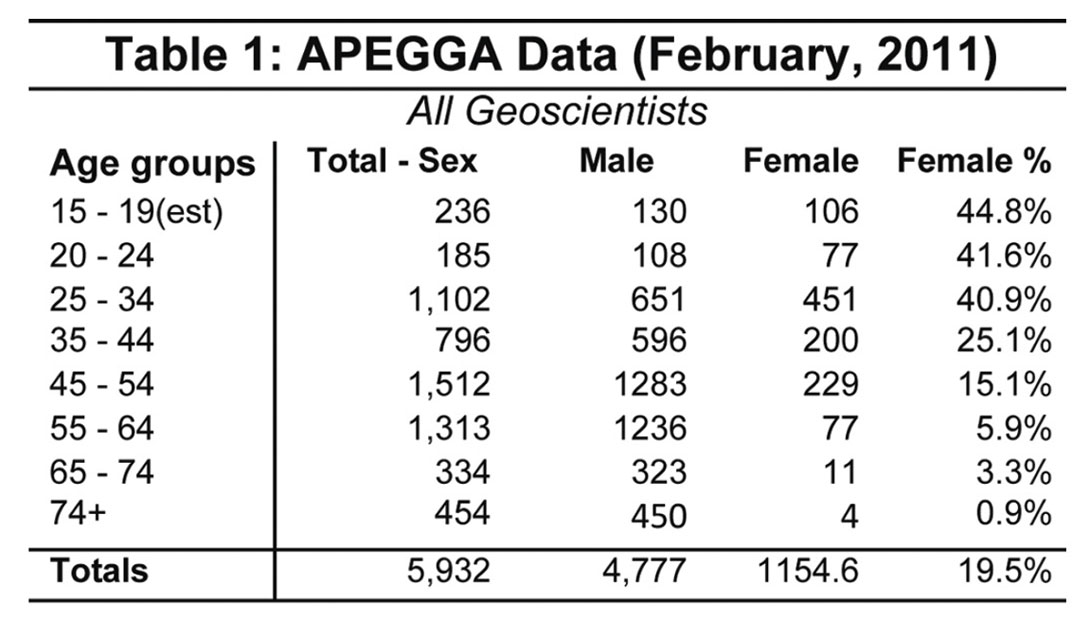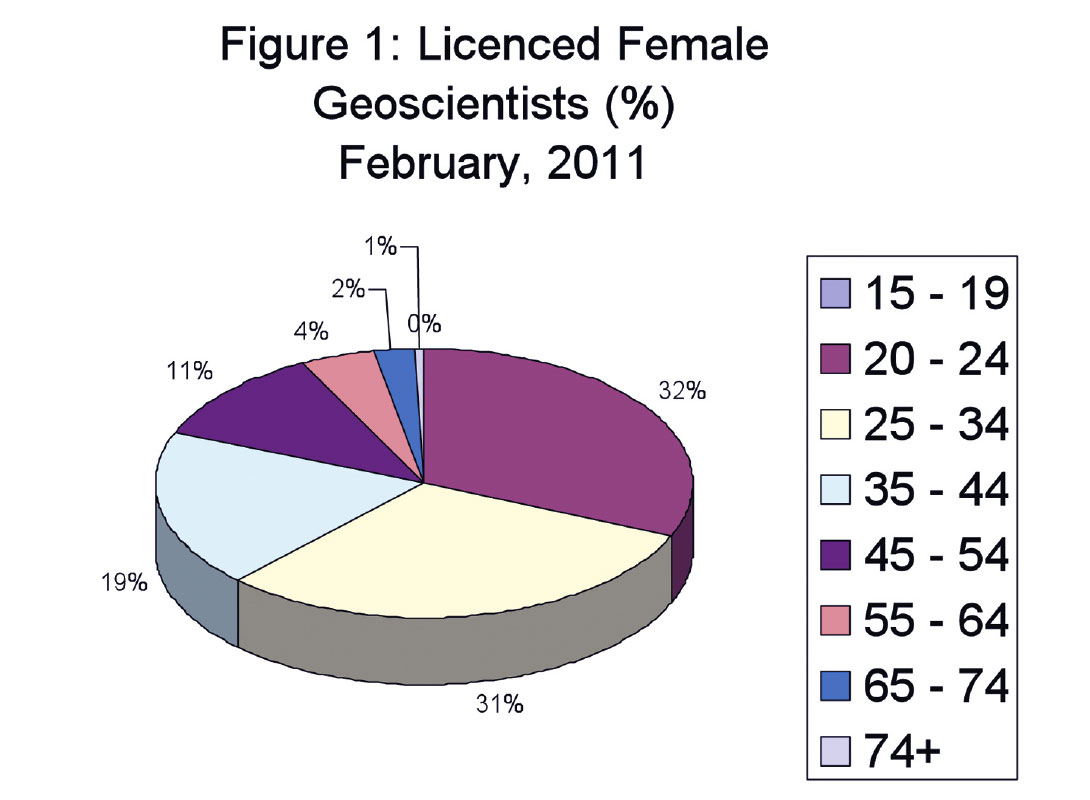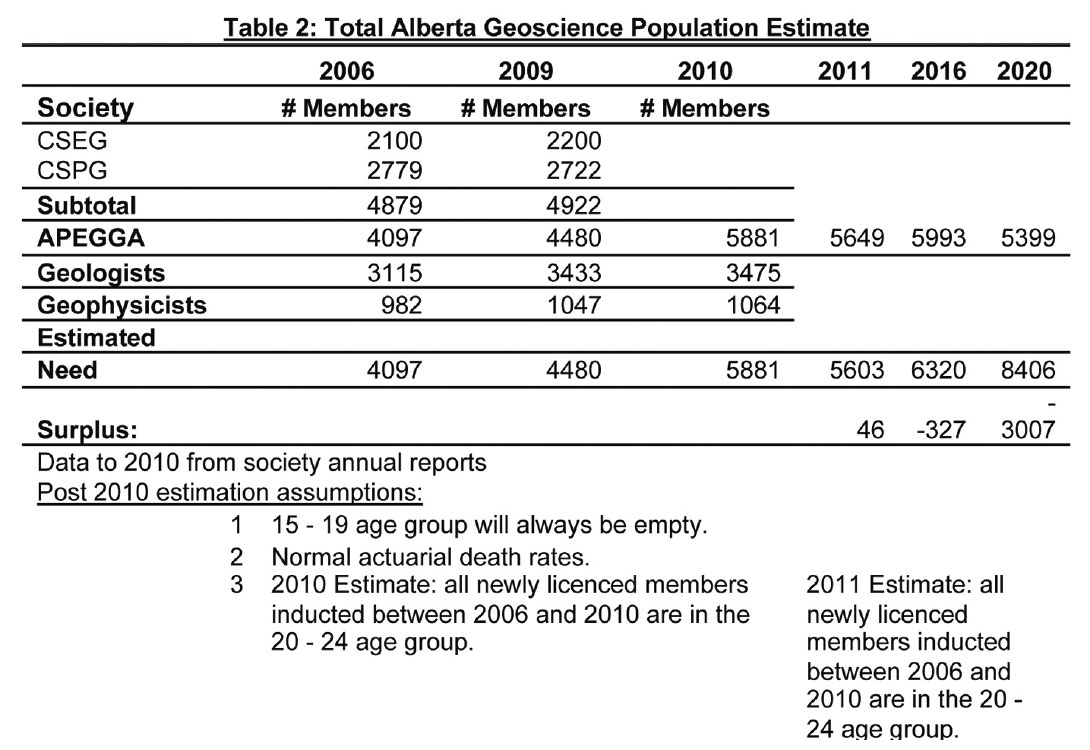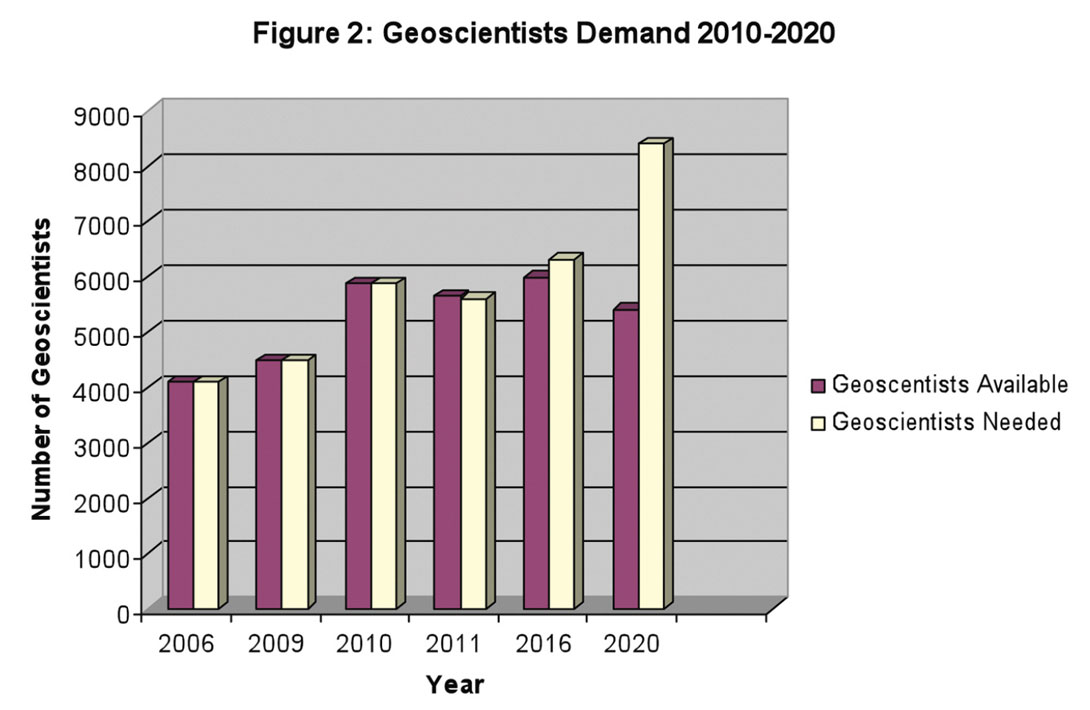Recently, John Townsley, P.Geoph. who is now Past-President of the CSEG, wrote at length about the changing demographic landscape in the geophysics profession and industry sector. His point of departure was an address to the APEGGA Calgary Branch by Kim Farwell, P.Eng., APEGGA President. The “good news” portion of his editorial was that we are approaching gender-equality in geoscience. The “bad news” portion is that there is nowhere near enough young people entering the profession to make up for projected losses at the high mileage end of the population pyramid. The APEGGA February membership data broken down by age and gender as shown in Figure 1 and Table 1 suggest John is exactly right.


The reasons for the peculiar double mode distribution are well known to readers of the RECORDER and do not need going over one more time. The answer to the lost generation of intermediate to senior geophysicists question is still open for discussion.
We, in the geoscience profession, are under-recruiting right now amongst the 15 to 17 year age group upon which our national economy will depend over the next two decades. We will also have to make an exceptional effort to keep the current 17 to 29 year age group on board if we are to find the resources to replace the proven oil, gas, metallic and nonmetallic minerals and industrial materials that Canada is producing right now. We may have the gender balance right, or nearly so, but the total number of new geoscientists appears to be below what we will need over the next decade. This is the New Wave in geoscience. Unfortunately, it is breaking just as the population tide is going out.
Immigration from elsewhere in Canada has always been an important source for new geophysical talent in Alberta. The bad news component for Alberta: there is a much smaller cohort registered in geoscience east of Winnipeg that is currently in 3rd and 4th year studies than there has been historically. Universities in Winnipeg and points west now account for 50.9% of all earth sciences undergraduates and 72% of all geophysics candidates (2009 Questionnaire preliminary results, Council of Chairs of Canadian Earth Science Departments [CCCESD] data). That survey covers the academic year from July, 2009 through June 2010.
The bulk of geoscience undergraduates from Ontario, Quebec and Atlantic Canada are doing environmental geology or engineering geology centred programs, as distinct from exploration and development of natural resources. It doesn’t appear we can count on our traditional hiring grounds in central and Atlantic Canada in the future.
Foreign trained geoscientists normally supply the remaining third of our needs. The trouble is, I haven’t met many lately. The countries that provide usual sources of supply in the Middle East, East Asia and Africa need every geo they can recruit at home. That leaves China, which will likely become the most interesting area for recruitment.
The China University of Geosciences in Beijing claims more than 40,000 graduates and, according to its website (www.cugb.edu.cn/englishweb/about.html) to have:
...12,000 undergraduates currently registered in 47 undergraduate programs; 118 graduate programs for a master’s degree, 37 doctoral programs, 16 fields of Master of Engineering, and 6 post-doctoral research stations. At present there are more than 12,000 students enrolled with a teaching and research staff comprised of 1,200.
In Canada (according to Statistics Canada in the 2006 census), we currently have an estimated 12,000 geoscientists in total, with about half of them in Calgary. This number is down from the 25,190 people claiming to be Geologists in 1996 (“An Analysis of S&T Workers Deployment in the Canadian Economy” Cat. No. 88- 006XIB-99003). The report does not differentiate between “Geologists” and “Geophysicists”, presumably because only Alberta differentiates between the two and the numbers didn’t warrant the effort required to do the subdivision of data. The Canadian Federation of Earth Sciences (CFES) issued a report entitled “Human Resources Needs in Earth Sciences in Canada – A preliminary Survey”, dated September 2008. Their survey estimated the total earth science population to be 15,000 in 2007. CFES is an inclusive organization that takes in academics, pedologists, those employed in geotechnology and paraprofessionals in geoscience as well. Allowing for the non-licensable population, the 12,000 figure looks to be a useable estimate. In the same year the survey was taken, Geoscientists Canada counted 8,160 Professional Geoscientists covered by its Constituent Association members.
From Table 1, it is clear we will need about 6,000 geoscientists to replace the over 55 crowd between now and 2020. If we hire and retain all 1,352 young people who are reported by CCCESD to be undergraduates now and the same number plus 50% more over the following 6 years, we are still going to need about 4,000 foreign trained people just to sustain the economic status quo (Table 2), with no growth in the resource industries.


The “no growth” scenario is unlikely to occur. In 2009, total crude bitumen production in Alberta was about 1.5 million bbl/d, according to “Alberta’s Energy Industry: An Overview 2009”, produced by the Alberta Government. Preliminary figures for 2010 suggest the current figure is 1.115 million bbl/d (ERCB Publication ST-3 “Supply and Disposition of Crude Oil and Equivalent”, January to November, 2010). The lower rate reflects the decline in conventional production outstripping added production from unconventional sources and reduced drilling effort during the recession period from 2008 until the present. Projected demand (using the 2010 Canadian Association of Petroleum Producers figures from its annual “Crude Oil – Forecast Markets and Pipelines) will need to rise to nearly double current production to 3.29 million bbl/d as soon as 2015 to meet Asian and domestic demand, even if the United States economy does not recover fully by then.
Since each incremental barrel of crude discovered requires more exploration effort than the last one produced (assuming all the easy oil has been found in the Western Canada Sedimentary Basin), both conventional and nonconventional, it follows that either Alberta will need more engineering and geoscience personnel or a step increase in exploration efficiency per explorer will be required to meet demand.
It appears that the long-awaited crisis in exploration brainpower has arrived, particularly in geophysics. It will be essential for the geoscience community to come together with a coordinated and enhanced outreach program that will encourage those who have left geophysics to return and if necessary, to requalify as Professional Geoscientists. A second approach will involve a targeted effort to interest young people in high school who have the right attributes for a career in geophysics to pursue it. Thirdly, university science students who have not yet committed to a specialty should be recruited into geophysics, stressing the long term benefits to be had in a valuable profession.
CSEG, CAGC and APEGGA are already working together through Seismic in Motion; SIFT (and the re-branded version to be rolled out later this year); Earth Sciences for Society and Geoscience Day at the Canmore Museum and Geoscience Centre. These initiatives reach middle school and high school students who haven’t committed to a career path.
Our existing events are good and essential starts, however they will continue to need refinement and the enthusiastic support of all active geoscientists to be successful. Further, the best outreach of all is for each one of us to encourage at least one family member and/or neighbour to seriously consider geoscience as a livelihood. Our critical role in the Canadian and Alberta economy demands it.











Join the Conversation
Interested in starting, or contributing to a conversation about an article or issue of the RECORDER? Join our CSEG LinkedIn Group.
Share This Article